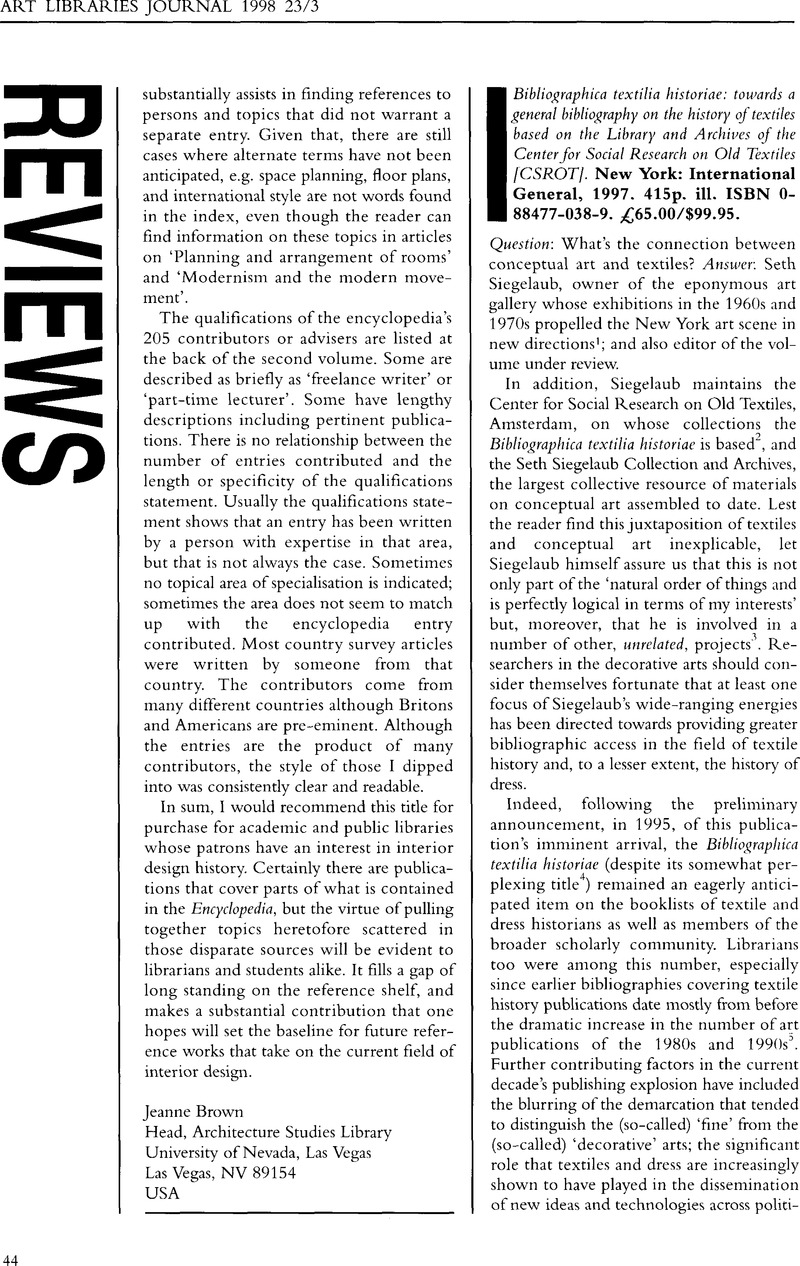No CrossRef data available.
Article contents
Bibliographica textilia historiae: towards a general bibliography on the history of textiles based on the Library and Archives of the Center for Social Research on Old Textiles [CSROT]. New York: International General, 1997. 415p. ill. ISBN 0-88477-038-9. £65.00/$99.95.
Published online by Cambridge University Press: 06 June 2016
Abstract
An abstract is not available for this content so a preview has been provided. Please use the Get access link above for information on how to access this content.

- Type
- Reviews
- Information
- Art Libraries Journal , Volume 23 , Special Issue 3: Special issue: Art libraries and art librarianship in France , 1998 , pp. 44 - 46
- Copyright
- Copyright © The Art Libraries Society 1998
References
1. For example, Carl Andre, Robert Barry, Daniel Buren, Jan Dibbets, Douglas Huebler, Joseph Kossuth, Sol LeWitt, Richard Long, N. E. Thing Co. Ltd., Robert Smithson, Lawrence Weiner. July, August, September 1969. The works were shown collectively only in the pages of the exhibition catalogue, thus turning it into a significant event in the conceptual art movement.Google Scholar
2. ‘The library was begun in the early 1960s in New York as a working library centered on reference books on oriental rugs, and was on loan to the Asia Society, New York, under the care of its first director, Gordon Bailey Washburn, from the mid-1960s to the early 1980s. In the beginning of the 1980s it was re-activated in Europe, and substantially re-oriented towards the general history of all aspects of textiles.’ Bibliographica textilia historiae, ‘Introduction’, p.20.Google Scholar
3. E-mail from Seth Siegelaub to this reviewer, 15th April, 1998 (italics this reviewer’s).Google Scholar
4. The Latin specialists at New York University with whom this reviewer has consulted remain mystified by the title’s syntax.Google Scholar
5. Such bibliographies include Arntzen, Etta and Rainwater, Robert. Guide to the literature of art history (Chicago: American Library Association, 1980); De Winter, Patrick. European decorative arts, 1400-1600: an annotated bibliography (Boston: G. K. Hall, 1988); Ehresmann, Donald L.
Applied and decorative arts: a bibliographic guide, 2nd edn. (Englewood, CO: Libraries Unlimited, 1993). {Bibliographica textilia historiae does not list the De Winter volume.) This reviewer is partly responsible for the (notably expanded) ‘Decorative Arts’ chapter of the new edition of the Guide to the literature oj art history, ed. by Marmor, Max and Ross, Alex (projected publication date: 1999).Google Scholar
7. As the Bibliographica textilia historiae points out, one of the first social histories of the working class was Gravenor Henson’s The civil, political and mechanical history of the framework-knitters, in Europe and America … (Nottingham, 1831). See Bibliographica textilia historiae, p.11, 164.Google Scholar
8. Siegelaub pays particular tribute to K. A. C. Creswell’s bibliographic compilations for Islamic art and architecture (‘Foreword’, p.7).Google Scholar
9.
Nider, Johannes. Tractatus de practibus marcatorum, a ‘theological treatise on the morality of commerce and business’. Bibliographica textilia historiae, p.243; also discussed on p. 17 where the work is slightly differently cited as Nyder, Johannes, De res marcatorium.Google Scholar


